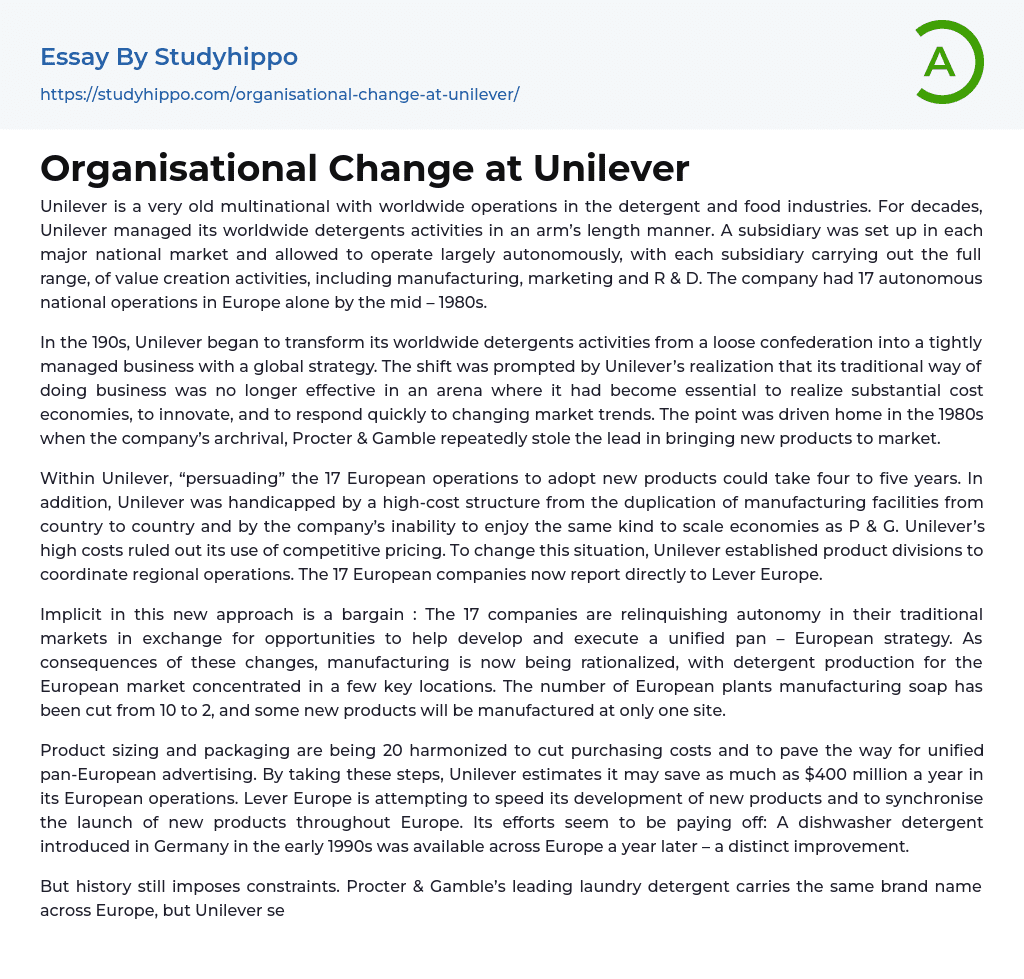Unilever is a multinational corporation that has a presence in the detergent and food industries worldwide. In the past, Unilever's detergent business was conducted separately in different countries. Each major market had its own independent subsidiary that handled all aspects of value creation including manufacturing, marketing, and research and development (R;D). During the mid-1980s, Unilever had 17 autonomous national operations solely in Europe.
Unilever started restructuring its global detergents operations in the 190s to create a more organized and global business strategy. This transformation was prompted by Unilever's recognition that their traditional methods were no longer effective in a market where it was crucial to achieve significant cost savings, innovate, and adapt quickly to evolving trends. The company realized the importance of this shift after Procter & Gamble consistently outperformed them in launchin
...g new products during the 1980s.
Unilever faced challenges in convincing all 17 European operations to adopt new products, a process that could take up to four to five years. Additionally, the company's high-cost structure, resulting from duplicating manufacturing facilities across different countries, and its inability to benefit from the same economies of scale as P ; G hindered its competitiveness. Unable to employ competitive pricing due to its high costs, Unilever implemented product divisions to streamline regional operations. As a result, the 17 European companies now report directly to Lever Europe.
The new approach involves a compromise where the 17 companies are sacrificing their independence in order to participate in and execute a unified pan-European strategy. This has led to streamlining of manufacturing processes, with detergent production for the European market now focused on a few key locations. The number o
soap manufacturing plants in Europe has been reduced from 10 to 2, and certain new products will be exclusively produced at one facility.
Unilever is consolidating product sizing and packaging to cut purchasing costs and facilitate unified pan-European advertising. By implementing these measures, the company expects to save up to $400 million per year in its European operations. Lever Europe's goal is to speed up product development and coordinate product launches across Europe. Their efforts have been fruitful, as a dishwasher detergent that was introduced in Germany in the early 1990s became available throughout Europe within a year – a notable enhancement.
Despite historical constraints, Procter & Gamble maintains a consistent brand name for its leading laundry detergent across Europe. On the other hand, Unilever sells its product under different names and has no intention to modify this approach. Unilever values the brand names it has established over a century and sees no benefit in abandoning them for the sake of pan-European standardization. In relation to the early 1990s reorganization, what was Unilever's previous strategy and organizational structure?
Is the strategy and structure of Unilever consistent? What are the advantages and disadvantages of this strategy and structure? By the 1990s, does Unilever's strategy and structure still align with the operating environment? If not, why? What strategy and structure did Unilever adopt in the 1990s? Is it suitable for the current competitive environment? What are the benefits and costs of this organizational and strategic shift?
- Wal-Mart essays
- Discover essays
- Factory essays
- Material essays
- Production And Manufacturing essays
- Alarm clock essays
- Advertisement essays
- Advertising essays
- Anheuser-busch essays
- Audience Theory essays
- Brand essays
- Brands essays
- Competitor Analysis essays
- Consumer essays
- Detergent essays
- Marketing Management essays
- Marketing Mix essays
- Marketing Plan essays
- Marketing Research essays
- Marketing Strategy essays
- New Product Development essays
- Point Of Sale essays
- Price essays
- Procurement essays
- Product essays
- Product Differentiation essays
- Product Placement essays
- Promotion essays
- Promotion And Marketing Communications essays
- Research Design essays
- Retailing essays
- Trademark essays
- Adaptation essays
- Adventure essays
- Adversity essays
- Aging essays
- Alcohol essays
- Barbie Doll essays
- Beauty essays
- Care essays
- Carpe diem essays
- Change essays
- Chess essays
- Chicken essays
- Choices essays
- Contrast essays
- Crops essays
- Development essays
- Dream essays
- Evil essays




